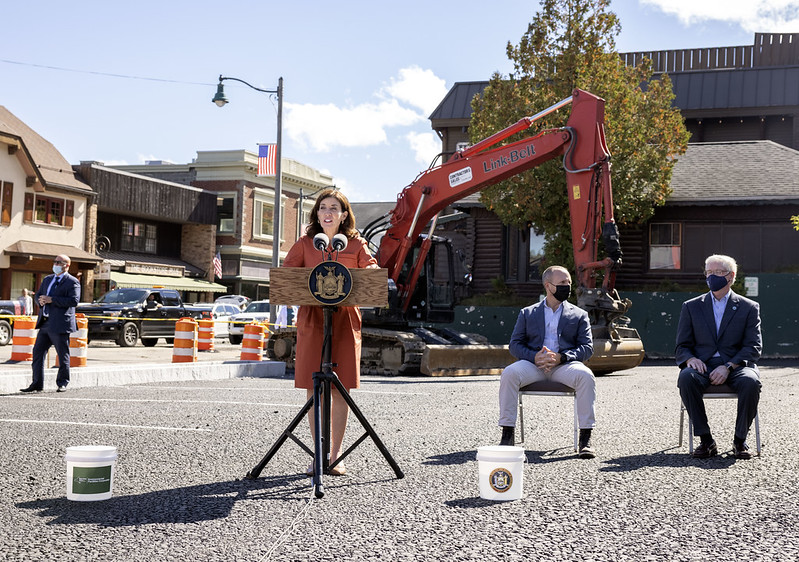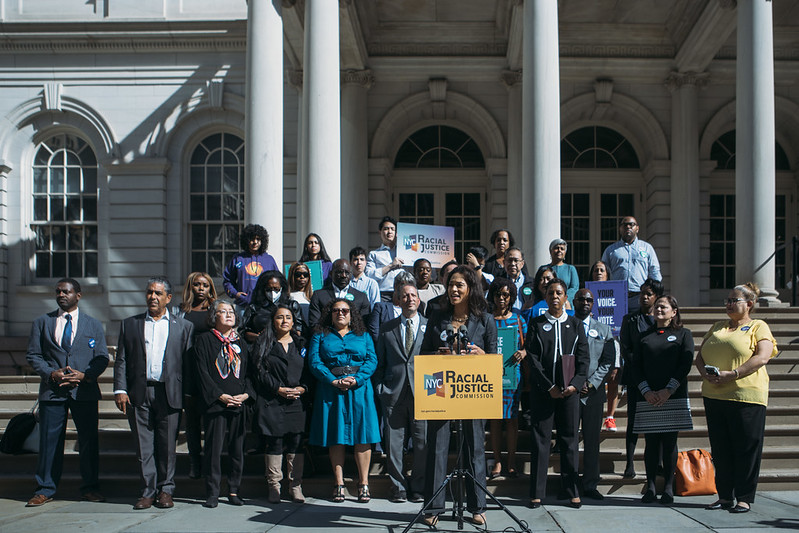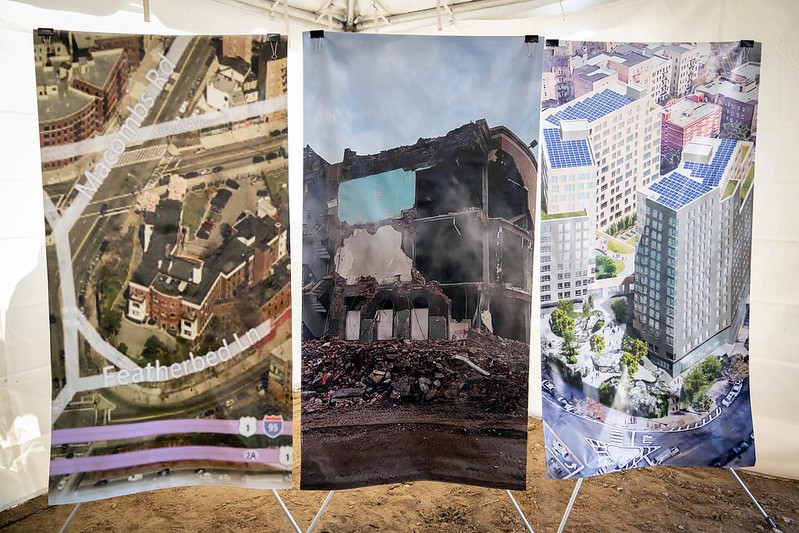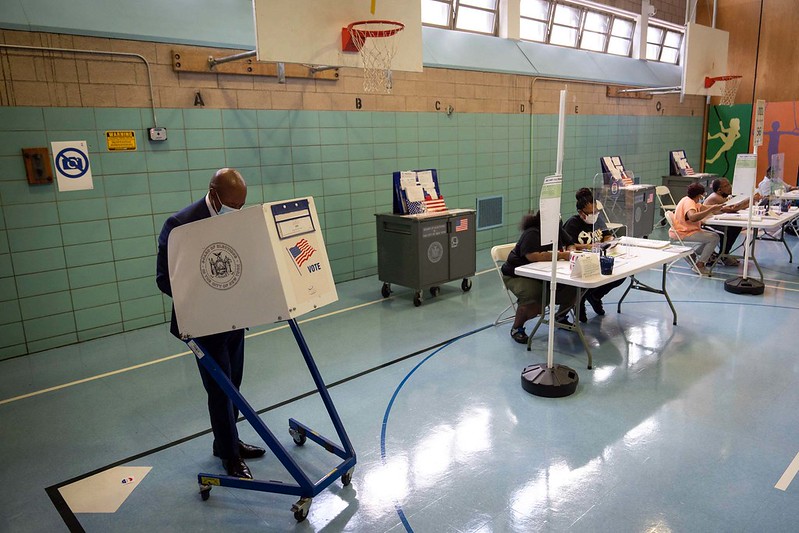Learning to See Each Other
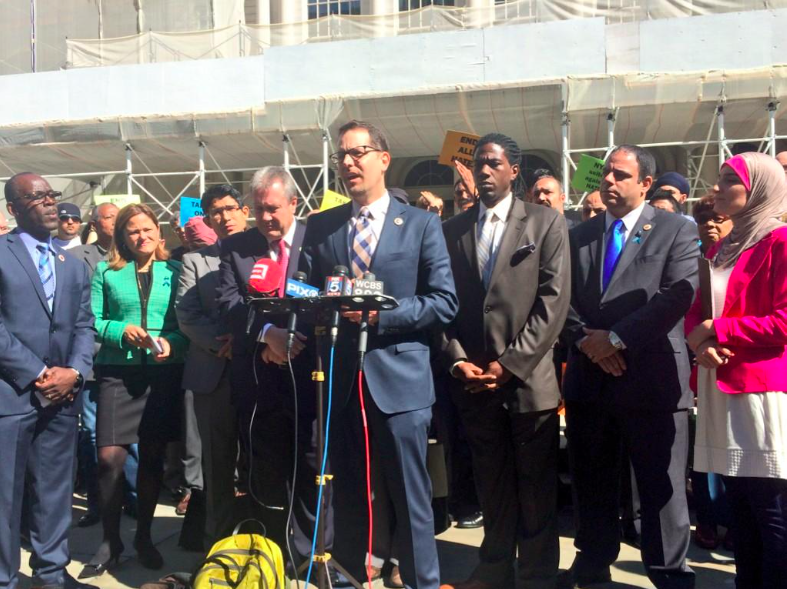
Council Member Mark Levine, the author (photo: @MarkLevineNYC)
Mayors and police unions have clashed for generations in New York City, conflicts which have often erupted in the form of work slowdowns by the cops in the trenches. But the scale and intensity of the current job action by rank-and-file officers is unprecedented. We're seeing dramatic drops not just in low-level ticketing but in nearly every category of arrest--including armed robbery and drunk driving.
It will require unprecedented action to pull our city back from this perilous precipice.
The level of vitriol in the public dialogue reached red hot levels in New York City following a grand jury's decision not to indict in the Eric Garner case and the heinous assassination of Detectives Wenjian Liu and Rafael Ramos. We can't heal the profound divisions in our city until we begin to heed the call, made by Commissioner Bill Bratton in his eulogy to Detective Ramos, to "learn to see each other."
That means reform activists must cease referring to police in dehumanizing terms. This includes demonizing all cops as racists or making the absurd accusation that the NYPD is equivalent to the KKK. It shouldn't take the murder of two police officers to remind New Yorkers of the difficult, stressful, and dangerous conditions that cops labor under day in and day out.
By the same token, critics of the reformers must stop saying that anyone calling for change in the NYPD is anti-police. Or that fighting against unequal treatment of people of color is slandering all cops. New Yorkers certainly have a right to expect that those charged with protecting us must not kill unarmed civilians, and to have a right to speak out when such tragedies occur.
The fact is that the vast majority of people on both sides of this divide want exactly the same thing. We want cops to be safe. We want crime to continue to go down. And we want everyone treated fairly regardless of their skin color. And yes--we want the police to be active and engaged, and we understand that proactive, community-centric policing requires more cops not fewer (which is why my colleagues and I in the City Council proposed the addition of 1,000 new officers last year).
All of which make the current enforcement slowdown perplexing and alarming. Policing, much like teaching, is a job requiring judgment. Even a 200,000 page manual would not be sufficient to stipulate how each aspect of the the work should be carried out. Policing works in New York City because nearly all cops care deeply about their mission of keeping the public safe and don't hesitate to go above and beyond their contractual obligation. Officers Andrew Dossi and Aliro Pellerano exemplify this spirit--having been shot last week in the Bronx responding to a robbery, even though they had just come off duty.
The current work slowdown runs counter to that heroic ethic. And it endangers millions of New Yorkers, robs the city of desperately needed funds, and undermines civilian control of the force.
It also diverts us from critical policy work aimed at making the NYPD the best it can be--reforms that will benefit not only the general public but cops as well. When we deploy body cameras it will enhance accountability on both sides of the shield. As we roll back the over-criminalization of marijuana possession it will free up critical police resources so they can be deployed to fight more serious crime. As we train cops on how to de-escalate potentially violent confrontations it will make everyone safer.
It is imperative that all of us--cops, activists, regular New Yorkers--start to truly see each other, and to understand that only by building on our common goals and aspirations can we live together as one city.
***
Mark Levine is the New York City Council Member for the 7th District, representing parts of the West Side of Upper Manhattan.
***
Have an op-ed idea or submission for Gotham Gazette? E-mail editor Ben Max: This email address is being protected from spambots. You need JavaScript enabled to view it.
NYCHA's Path to Privatization?
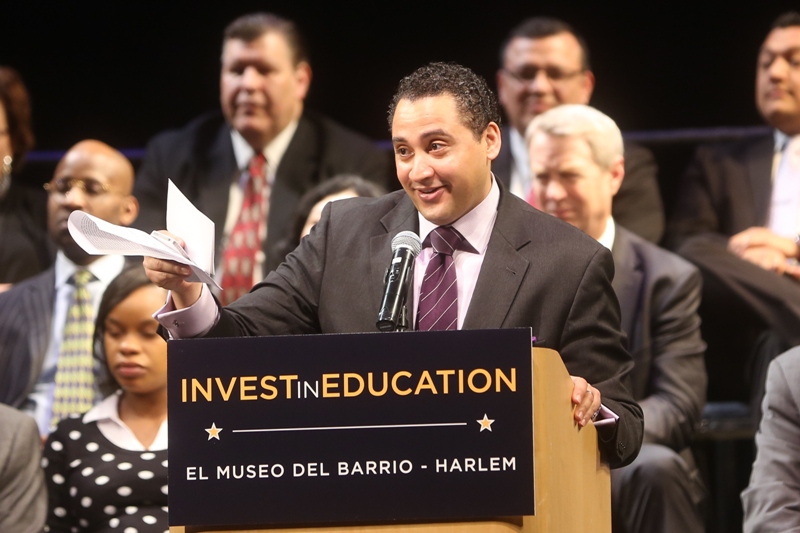
AM Rodriguez speaking at a community event (photo: @_rjayrodriguez)
As it currently stands, NYCHA's 2602 buildings spread across 334 developments, serving more than 615,000 people, are in need of $18 billion for major building repairs and upgrades. The area I represent in East Harlem has the highest concentration of public housing in the State. This state of disrepair is both a natural result of aging housing stock and a failure to properly invest in the regular maintenance of these buildings. The plan recently introduced by NYCHA to sell a 50% stake in six developments in exchange for an immediate cash infusion is an intriguing approach to this massive problem, but this deal requires closer scrutiny. Furthermore, it raises significant questions about the federal government's future role in providing housing subsidies.
There is no doubt that the massive needs of these buildings to meet even the most basic standards of living for NYCHA residents will require creative thinking. As a proponent of Public Private Partnerships, I can appreciate the role of the private sector in working with the government to provide better services and encourage it. The deal raises significant capital dollars for these buildings and others in the portfolio, where little or no money existed before. Based on the original financing structure, we are told it is not replicable across the portfolio. On the surface, raising money to fix the buildings makes sense, but there is more to any deal involving NYCHA. In fact, I struggle to see how this fits into the long-term affordable housing plan for New York City. Is this "pilot" part of a larger plan to diminish the City's stake in housing?
The recently revealed plans include private developers, paying $150 million for the initial sale in exchange for 50% interest in the six developments. NYCHA is also set to receive $100 million over the next two years and an additional $100 million in revenue over the next 15 years. Making this deal work for the developers is that the federal government would now be paying the developers the difference between the rents that are currently being collected and market rate rents. Also in the deal, the developers will be able to sell tax-exempt bonds and federal tax credits for the 30-year life of the deal. At the expiration of the contract, the developers may be given the option of buying the remaining 50% interest and turning all of the apartments into market rate units.
The biggest red flag in this deal are the details, or lack thereof, surrounding the developers' ability to take the units to market after 30 years. As we've seen with the Mitchell-Lama program across the state, a failure to ensure permanent affordability upfront has led to thousands of affordable units vanishing. With diminishing commitments from the federal and state governments, NYCHA will almost certainly be less empowered to keep their stake 30 years from now. I've asked NYCHA to consider a deed restriction, which would require the property be kept as affordable housing in perpetuity. It's not enough to "promise" not to sell after 30 years; a more permanent legal protection is required.
NYCHA's partner selection, particularly the absence of an MWBE business partner, is also troubling. With both the City and State applauding their improvement in engaging with minority and woman partners at the MWBE conference this past October, and the commitments of the de Blasio Administration to MWBEs, this strikes me as a perfect opportunity to expand these relationships. With two of the developments included in this deal, Milbank-Frawley and East 120th, located in East Harlem, we have no shortage of local minority-owned developers, contractors, property managers, or workforce providers that could have participated in this deal.
Another concerning aspect of this deal is the property management contract, which has been awarded to an affiliate of the developer as a bundled service. NYCHA maintains that in its ownership role it has the ability to fire the property manager if it finds the manager's performance to be negligent. It seems like we have the fox looking after the coop. How can NYCHA, which has historically failed to perform its duties as property managers, be the sole arbiter of negligent performance? Furthermore, the business partnership between NYCHA and the developer is inherently a relationship that would make any change in management company a challenge. If this is a model the City is looking to expand upon in the future, how are we able to protect our tenants from neglectful management?
It is our responsibility to approach this problem in a way that confronts the challenges of today, while ensuring that the New York of tomorrow provides equitable opportunities. Unlike the previous administration, which claimed that prior infill development or privatization attempts were exempt from the ULURP process, I ask that Mayor de Blasio allow closer scrutiny of this deal and add additional checks and balances to ensure we are meeting our responsibility to provide high quality public housing.
Most important, this is the sort of solution that results from the current model of federal HUD (Housing and Urban Development) funding. I think we should allow ourselves to think more broadly about how the federal government supports housing and ensure that a larger stake is invested in the community and the current residents themselves. This starts with ensuring that local and MWBE developers are given an opportunity, and this extends to property management, construction jobs, and the other areas of economic impact. I look forward to having this conversation with Mayor de Blasio, the City Council and, most critically, the community members themselves.
***
Robert J. Rodriguez is a State Assemblymember Representing East Harlem/El Barrio and the Upper East Side. He is the Chair of State's Mitchell Lama Subcommittee and a Member of the Housing Committee.
***
Have an op-ed idea or submission for Gotham Gazette? E-mail editor Ben Max: This email address is being protected from spambots. You need JavaScript enabled to view it.
We Can't Ignore Family Roots of School Behavioral Problems
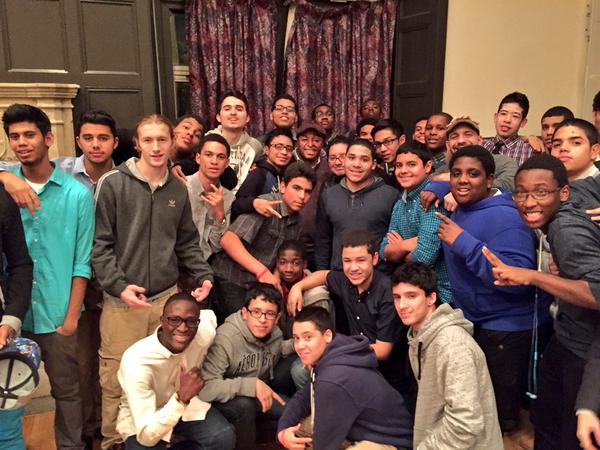
Students in a City DYCD writing program (photo: @NYCYouth)
There is no question that black men face substantial barriers to employment. As the demand for men with limited educational credentials has declined, firms increasingly screen out all men they perceive are from at-risk groups: those with criminal records, those who live in high-crime areas, and those who cannot provide reliable personal recommendations for their employment worthiness. As a result, high black joblessness appears among teenagers and persists among those in their prime working years. In particular, the employment rate among black men aged 25 to 34 years old is 70 percent, in contrast to 83 percent for similarly-aged white men.
In response, there are an increasing number of programs to prepare at-risk youth for the world of work. In Brooklyn, CAMBA has done very positive work with kids in the transfer high schools - schools for students who had previously dropped out or were significantly behind in credits; United Neighborhoods gains employment for disconnected youth – those who are neither in school nor in paid employment; and organizations like STRIVE work with those leaving the prison system. There should be greater funding for these successful initiatives.
Many observers believe that one of the barriers black youth face is the racial disparities in school discipline. In New York City, black youth comprise 26 percent of the student population but 53 percent of suspensions. Generally, commentators focus on what can be done in the high schools and certainly, in many cases, alternatives to suspensions are needed. But changes in high school disciplinary policies or expanded work readiness programs for at-risk youth can only do so much. It would be much more effective to intervene early so that fewer black males reach their teen years with deficient academic skills and/or significant attitudinal problems that put them at risk for failure in the educational system and in the workplace.
Behavioral problems appear at an early age. Black children comprise 18 percent of preschoolers but 48 percent of those suspended multiple times. The evidence strongly suggests that an important source of these behavioral problems is the fluid family environments that many black disadvantaged children experience. With less stable male income, blacks have less stable romantic relationships.
Over their lifetime, 59 percent of African American mothers, 35 percent of Hispanic mothers and 22 percent of white mothers reported having children with more than one partner.
Kathryn Edin, a professor and researcher on women and poverty, noted, "When a mom moves from one relationship to another – playing gatekeeper with the biological father while putting her new boyfriend into the dad's role - she puts her kids on the 'father-go-round.' What about fathers? They, too, find themselves on a 'family-go round,' having kids by other women in a quest to try to get what they long for – the whole father experience."
These changing relationships create stress for children for a number of reasons. First, many children are abandoned by their biological father when he moves on to a new romantic relationships. A Pew survey found that over half of fathers did not share a meal with their noncustodial children in the last four weeks; less than one-third did homework with them.
Second, children must adapt to a new man in the house; someone who sometimes brings his employment frustrations into the home.
Surely one of the outcomes for many children is to act out in school. This is especially the case for young boys who have additional school problems and stresses.
Adolescents with a half-sibling with a different father are about 65 percent more likely to have used illegal drugs by their 15th birthday than those who have only full siblings. Among fatherless boys, those who lived with stepfathers were at an even greater risk of incarceration than those who lived with a single mother.
When these young children exhibit behavioral problems in schools, in many situations school disciplinary actions are warranted. Educators know, however, that disciplinary actions alone will not change the situation: counseling for both the child and the adults in his family would be more constructive. The problem is that counseling resources are not available in many K-5 settings. Even when parents are amenable, the referrals put them on waiting lists and even out-of-class resources for troubled children are often not available. Indeed, in too many cases, the only way that these troubled children gain resources is if they are (mis)placed in special education classes.
Reducing suspensions without providing the necessary resources to aid in the transformation of the home environment will be of limited value. Many more resources are necessary to respond in a holistic approach when children act out - and Mayor Bill de Blasio's approach to failing schools points in the right direction. Counseling and social work resources should be a priority if we really want troubled children to succeed.
***
Robert Cherry is Stern Professor at Brooklyn College and the CUNY Graduate Center.
***
Have an op-ed idea or submission for Gotham Gazette? E-mail editor Ben Max: This email address is being protected from spambots. You need JavaScript enabled to view it.
Senator Serrano: Priorities for 2015
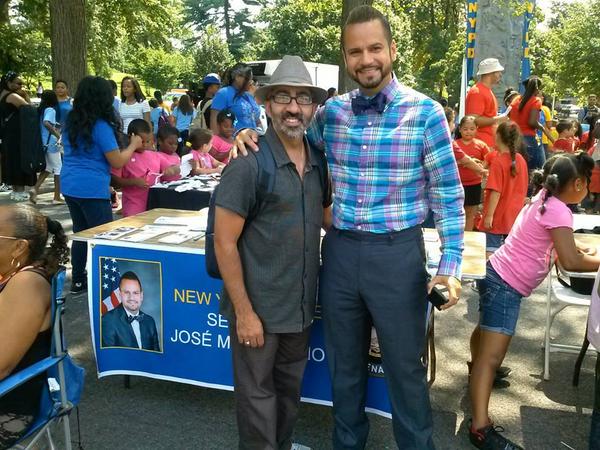
Sen. Jose M. Serrano, right, with a constituent (photo: @johnhenrysoto)
With the 2015 Senate session rapidly approaching, the time has come for all legislators to outline their priorities for the new year. Putting the previous elections behind us, the time has come for all of us to work together for the common good. The people of New York State are far less concerned with the political squabbles in Albany, they're demanding real action now.
I, for one, remain hopeful that all senators can find common ground while working together in a constructive manner to address many of the issues and concerns the voters have entrusted us to tackle. While new issues present themselves on an almost daily basis, some long-standing problems have lingered for years without substantive action.
On various issues like the DREAM Act, the Women's Equality Act, and raising the minimum wage for hard working New Yorkers - the time is long overdue for positive legislative measures. Other issues, such as rent regulation laws, require immediate action and will be at the forefront this year. Additionally, tragic events have recently shined a bright light on the need to reform the criminal justice system in ways that will inspire confidence and ensure equal justice for all New Yorkers.
Perhaps this year's biggest battle in Albany will revolve around New York City's rent regulation laws, which are set to expire on June 15. I will join many of my progressive colleagues in fighting to pass pro-tenant legislation. We will fight to ensure that average, hard-working New Yorkers can remain in their homes and raise families in a city that isn't exclusively for the very wealthy.
Ensuring high quality housing for the working class is essential to New York maintaining a robust local economy. For too long, we have been moving in the wrong direction when it comes to affordable housing. Estimates suggest that roughly 400,000 affordable housing units in New York City have been lost over the last 12 years, which has only served to further squeeze the poor and middle class.
To help combat this alarming trend, I am proud to sponsor bill S1040, which will repeal the often-exploited "statutory vacancy bonus." Currently, landlords unfairly benefit from the statutory vacancy bonus by increasing the rent up to 20% in the event of a vacancy of an affordable unit. Each time a landlord is able to increase rents in this fashion, they get closer and closer to the decontrol threshold, until eventually the apartment is phased out of rent regulation and removed from affordability status. The negative result of this has been that many New Yorkers are forced to leave their homes in search of more affordable places to live. My bill, along with other pro-tenant reforms advanced by the Democratic Conference, would help change this and ensure that affordable housing remains affordable.
Recent, highly publicized cases, both nationally and locally involving police and civilian interactions have created a firestorm of debate both in the media and on our streets. This debate focuses on much needed reforms to our criminal justice system which are designed to inspire confidence in the system. Toward that end, my Democratic colleagues and I have recently announced the introduction of a legislative package implementing a permanent Office of Special Investigation to review any interaction between a police officer and an unarmed civilian that results in the death of that civilian. I wholeheartedly believe that the overwhelming majority of police officers work honorably, while showing great restraint and respect for the communities they serve. They risk their lives each and every day to ensure that we can live in safe communities and raise our families without fear of criminals. When there are questions about conduct, I feel it's important that an independent and transparent process be implemented to ensure that communities feel confident that justice has worked its course.
Our nation was built by generations of hard-working immigrants who came to America seeking new opportunities. The DREAM Act would honor this legacy by giving immigrant students access to higher education, and with that a chance at achieving the American Dream by providing undocumented students access to financial aid. Despite the Democratic Conference providing an overwhelming amount of votes in support of this legislation, we unfortunately were not able to make this DREAM a reality. The DREAM Act is not only the right thing to do, but a common sense way to ensure we have a well-educated workforce ready for the challenges of the future. As the immigrant population continues to grow throughout the state, it's my hope that we can work together to show our friends across the aisle that every student, regardless of documentation, deserves the opportunity to achieve their dreams.
Passage of the full 10 point Women's Equality Act is another major objective of the Democratic Conference. The Women's Equality Plan was proposed by Governor Cuomo in order to bridge the gender gap that (shockingly in this day and age) still remains in so many segments of society. This plan not only promotes fairness and equal opportunity for the women of New York, but it also bridges income disparities due to gender discrimination. The complete 10-point Women's Equality Plan is a commonsense approach to achieving equal pay, alleviating sexual harassment in the workplace, ending family status discrimination, and, so importantly, protecting a woman's freedom of choice. Numerous polls have shown that the majority of New Yorkers support the full 10-point plan and it is imperative that we put the State of New York at the forefront of women's rights.
Continuing the fight for fair wages and combating income inequality is another top priority for 2015. It is heartbreaking that over 1.1 million hardworking New Yorkers struggle to provide for their families, and live below the poverty line despite having full-time jobs. If we are able to increase the minimum wage, individuals will invest more in their local economies and help generate greater prosperity for communities throughout New York State. The cost of living in New York State is growing increasingly more expensive and wages are not climbing at a similar pace, and this is especially true in places like New York City. Our city has the highest cost of living in the entire state, making it harder for families to pay their rent and put healthy food on the table for their children. Therefore, we will also be fighting to allow New York City to set its own minimum wage.
Our work in Albany will not be limited to the issues highlighted above. Every member of the Democratic Conference will have their own personal priorities and legislation. As the Ranking Member on the Senate Committee on Cultural Affairs, Tourism, Parks & Recreation, I will continue to fight for more arts education in our classrooms while pushing for better compliance with regulations that mandate music and art be taught in all schools. I will advocate for preservation of and improvements to our beloved state parks, while working to further promote our cultural sector as the major economic engine that it is. Studies have shown that investments in our state parks yield a 5:1 return. Each year seems to be record-breaking for tourism in places like New York City - and we have our cultural institutions and organizations to thank for that.
Just as I have throughout my career, in 2015 I will continue the fight for improved ethics and transparency within New York State government. An updated ethics package will strengthen our campaign finance rules by increasing transparency and punishing those who abuse their position in government. One of my bills would establish a review process for member items (S.920) while helping to root out corruption and conflicts of interests in a process often veiled in secrecy. My legislation will ensure transparency and inspire confidence, while giving power back to those who know best the needs in their community - the local elected officials. This measure, combined with campaign finance reform and others, represent huge steps we must take towards restoring public confidence.
As the Chair of our Democratic Conference, it is an honor for me to work with such a dedicated and energetic group of individuals. I am proud of all we have accomplished, but I'm far more excited about the work that lies ahead. I have spent my nearly 14 years as an elected official, both in the New York City Council and the State Senate, working hard to build coalitions, bridge gaps and find common ground while fighting for issues that our communities demand action on. Whenever partisan politics are put aside, good things happen and our constituents are the greatest beneficiaries. I look forward to joining my colleagues in Albany in the coming months as we tackle the tough work before us.
***
State Senator Jose M. Serrano represents District 29, which includes parts of the Bronx and Manhattan. Senator Serrano is the Chair of the Senate Democratic Conference and serves as the Ranking Member of the Senate Committee on Cultural Affairs, Tourism, Parks and Recreation. Find him on Twitter at @SenatorSerrano.
***
Have an op-ed idea or submission for Gotham Gazette? E-mail editor Ben Max: This email address is being protected from spambots. You need JavaScript enabled to view it.
The Promise - and Preservation - of Queens
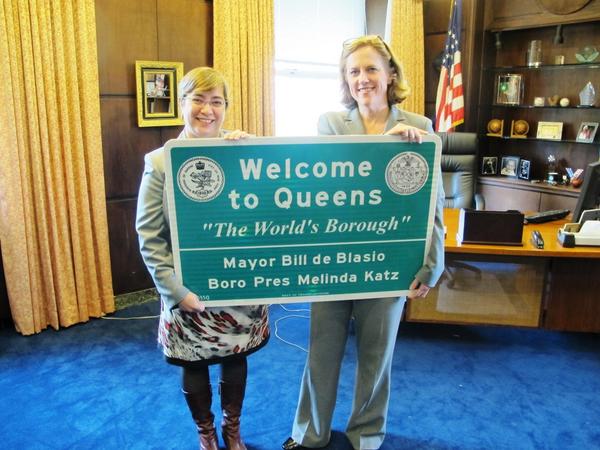
Queens BP Melinda Katz, right, with a DOT rep (photo: @MelindaKatz)
Lonely Planet travel guide recently named Queens as the number one destination on its 2015 Best in the US list, even calling it the "next Brooklyn." The New York Times, New York Magazine, and a flock of influential food, culture, and real estate bloggers agree, Queens is on the rise. Manhattanites who once might have moved to Brooklyn now consider relocating to Long Island City or Astoria for lower median rental costs, often-larger apartment units, affordable neighborhood amenities, and proximity to Midtown Manhattan.
Though Queens has been relatively untouched by the development and population shift that dominated much of Brooklyn over the past decade, the success of new luxury residential developments in western Queens, and large development projects in Flushing, Corona, and Willets Point have developers dreaming of new glass high-rise residential towers, restaurateurs salivating over customers willing to drop $17 on dinosaur kale salads, and bar owners anticipating sales of $14 muddled cocktails.
Mindful of the downside that follows uncontrolled growth, New York City and Queens must plan ahead to ensure that Queens remains vibrant, economically and culturally diverse, affordable, and unique.
On the eve that Queens threatens to become "the next Brooklyn," New York City must quickly takes steps to insulate the community from the harm that unbridled gentrification might bring. Queens has the opportunity to get it right; we can simultaneously welcome new neighbors and preserve existing communities and cultural resources. Strategic, coordinated county-wide planning must place the unique cultural aspects of Queens on par with development.
The largest borough has much to offer newcomers and long-time residents alike. The county is served by several subway lines, and is home to the city's airports, nationally respected museums, the Mets, and the US Open. The county is geographically diverse, with enviable views of the East River, Queensborough Bridge, and the Manhattan skyline; beautiful beaches to the east, and picturesque parks and neighborhoods in between. Queens has the second largest, though most diversified, borough economy, and good public schools.
However, its most remarkable and unmistakable quality, the unique asset that separates Queens from other boroughs, is demographics. Queens is the most diverse large urban area in the United States. Half of Queens' residents are foreign born. Its citizens make up about 100 nationalities and ethnicities and speak 140 languages. Flushing hosts one of the largest and most vibrant Chinatowns in America. A large Greek community lives in Astoria. South Asians and Central and South Americans prosper in Sunnyside and Jackson Heights. In Corona, a long-term Italian-American neighborhood has enjoyed an influx of Latin-American residents and businesses. Other communities, including Egyptians, West Indians, and Irish, prosper as well.
With one of the five boroughs' largest African-American communities, Queens is a significant cultural stronghold with a rich history. Charlie Parker, Ella Fitzgerald, and Louis Armstrong lived there during the Jazz Era. Armstrong's home is now a museum, and it regularly hosts live outdoor jazz performances. A number of contemporary African-American musical artists are from Queens, including 50 Cent, Nicki Minaj, LL Cool J, Mobb Deep, Nas, Run-D.M.C, and A Tribe Called Quest. Two prominent African-American theater companies are based in the county.
Long regarded as a bedroom community, Queens residents are family-oriented and middle class, with 68% of its residents living in family units, and 29% with children. Home ownership rates are nearly double that of Manhattan, Brooklyn, or the Bronx.
Queens boasts the most diverse religious community in America. There are 200 houses of worship within a 2.5 square-mile, densely populated Flushing neighborhood, including half a dozen Hindu temples, two Sikh gurdwaras, over 100 Korean churches, and many mosques, churches, and synagogues.
New York City has a number of tools that could be used to help maintain what is unique about Queens.
Skyrocketing rents and unrealistic real-estate price hikes that accompany gentrification push out long-term residents, and invite unwanted speculation. Safeguarding the community requires preservation of affordable housing. The City's inclusionary housing program should be mandatory, and targeted expansion of the City's homeownership assistance program to vulnerable populations can help attract and retain neighborhood culture. Non-profits should be encouraged to buy housing units in designated areas so long as they rent to economically vulnerable populations at below market rates.
Communities remain viable and resilient when neighborhood businesses prosper. Queens is an amazing patchwork of 40,0000 small businesses that support their owners and create local jobs. Many of these businesses cater to specific ethnic communities and thereby help to ensure a vibrant, culturally diverse environment. To help protect existing business, and encourage new ventures, the City can aggressively expand the reach of its Business Improvement District (BID) program within Queens to help with business development, capital improvement, marketing, public area maintenance, and representation before city government. The City can also implement cultural preservation districts to help prevent displacement of local business and cultural anchors.
The New York Economic Development Corporation (EDC) should continue to encourage land-use planning that incorporates local manufacture and light industry in order to bring good, well-paid jobs to the borough, and tamp down overzealous real estate speculation. The City should facilitate incubators focused on development of local entrepreneurial ventures. While encouraging business development, the City must continue to regulate "big-box" and chain stores that pay low wages, insufficient benefits, unfairly compete with local business, and funnel money out of the community.
Current state law does not allow New York municipalities to control the minimum wage within their boundaries. The De Blasio administration should continue to advocate for local control in order to raise the minimum wage and thus increase economic stability and purchase power.
The promise of Queens is not in what might be imported, but what is already here. But change is inevitable. Instead of framing gentrification as a zero sum game, the City should encourage a vision of neighborhoods as shared space, where the benefits and talents of new and often affluent residents are valued, while local businesses and cultural institutions are protected with public investment of money and expertise.
Though Queens is less vulnerable to gentrification due to the high level of homeownership, large numbers of people living in family units, substantial and healthy local business, and a solid middle-class base, the probability of permanent change that diminishes the unique character of the borough is high. By ensuring communities have adequate stock of affordable permanent housing, vibrant and diverse businesses that cater to local needs, and a government that prioritizes diversity along with economic development, Queens will be the face of America as a model of diversity, economic opportunity, and good quality of life.
***
Michael Greenberg is an attorney and Queens resident. Find him on Twitter @GreenbergSez.
***
Have an op-ed idea or submission for Gotham Gazette? E-mail editor Ben Max: This email address is being protected from spambots. You need JavaScript enabled to view it.
2015 Legislative Priorities for LGBT New Yorkers

(photo: @prideagenda)
A new year means a fresh start in the continued fight to further equal rights for lesbian, gay, bisexual and transgender (LGBT) New Yorkers and our families. For us, 2015 marks the 25th anniversary of New York's LGBT advocacy organization, a milestone that parallels an important shift we're seeing as we turn the corner on visibility and enter our second quarter century.
With marriage equality recognized in New York and rapidly expanding to more and more states throughout the nation, the focus is turning to the other important priorities that were previously silenced, but arguably even more pertinent when it comes to life and death issues that impact our community.
The Pride Agenda's number one legislative priority is the Gender Expression Non-Discrimination Act, or GENDA. This bill, which we've been advocating for more than 12 years, will secure long overdue basic civil rights for transgender New Yorkers, including protections from discrimination in housing, employment, public accommodations, and when seeking an education and credit.
As it stands, New York is behind more than one third of the country when it comes to including gender identity and expression as a protected class. GENDA saw its seventh passage through the New York State Assembly in 2014, but failed to come to the floor for a vote in the Senate yet again. We'll work closely with legislators on both sides of the aisle, including the nearly 100 we endorsed in the 2014 election season, to advocate for its passage in the 2015 legislative session.
We're also fighting to protect our youth from damaging and discredited conversion therapy, a practice where so-called mental health professionals licensed by the State of New York try to deny a young person of who they are. While the methods vary, none are sanctioned by any medical association – in fact, every major medical association has denounced the practice as harmful – and they are proven to leave lasting harm on young LGBT people who should instead receive affirming therapy if they're struggling to come to terms with their sense of self.
The bill to ban conversion therapy, a version of which has already become law in California and New Jersey under Republican gubernatorial leadership, passed in the New York State Assembly the first time it was introduced earlier in 2014 with resounding bipartisan support. Again, the bill got blocked from coming to a vote in the Senate, but the indication in the Assembly and the number of cosponsors of the bill in the Senate are strong signs that we will see this become law soon.
In addition to protecting our youth and transgender New Yorkers of all ages, we're fighting for greater protections for our families. New York, perhaps surprisingly, has some of the most outdated laws on the books when it comes to family building options. Contractual surrogacy, or having a baby with the help of a gestational carrier, is illegal in New York. The law is the harshest of any state with criminal penalties as punishment for entering into an agreement.
This means families who can't carry a child to term, either due to health concerns or because the household is headed by two men, have to leave their home state to work with a surrogate in a state where the practice is not banned, adding a complex and frightening array of medical, legal and logistical hurdles to an already emotional and stressful endeavor. LGBT couples have to travel to states like Kansas, which don't have basic civil rights protections in place for our community, but which have better laws when it comes to family creation.
In addition, New York law has not caught up with current family dynamics and we're fighting to bring us up to speed. For instance, intended parents have to wait until 45 days after their child is born before they're able to file for adoption if they're not biologically related. That means the child hangs in legal limbo while a sperm or egg donor has more rights to a child they never intended to parent than does the actual parent. Current law also creates harrowing uncertainty when it comes to making critical health decisions at the time of birth, insurance coverage, travel and other legal logistics. We need laws that provide safe and regulated framework so that we can create and protect our families here at home in New York.
As we enter our silver anniversary in 2015, we also celebrate our 20th anniversary of the facilitators of the LGBT Health and Human Services Network. Composed of more than 50 organizations that serve 1.5 million LGBT New Yorkers and our families in all 63 counties throughout the state, the Network delivers care that ranges from medical and mental health services to anti-violence resources and shelters, after school programs, community centers, and much more. We'll continue to convene this important group of groups and advocate for fair funding in the state budget so these organizations can continue to provide critical direct services to our community, which faces disproportionate inequities when it comes to health and safety.
In 2015 and beyond, the Pride Agenda will continue to advocate for the many disparities that impact LGBT New Yorkers with the ultimate goal of one day creating a truly equal and just Empire State.
***
Nathan M. Schaefer is the Executive Director of Empire State Pride Agenda; follow Nathan on Twitter @NathanMSchaefer.
***
Have an op-ed idea or submission for Gotham Gazette? E-mail editor Ben Max: This email address is being protected from spambots. You need JavaScript enabled to view it.
Supportive Housing Helps Solve Homelessness
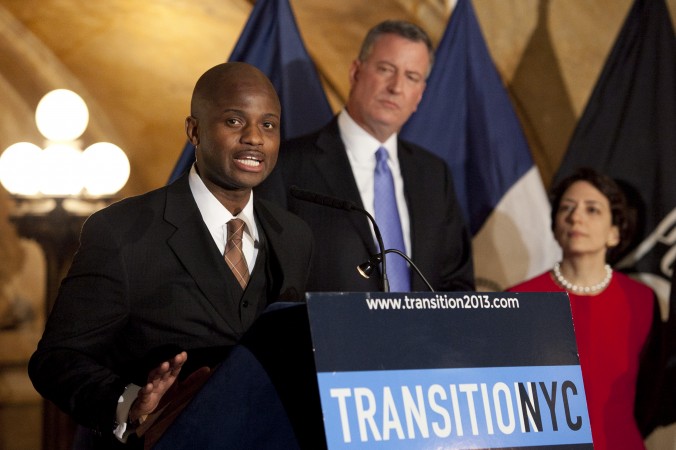
Homeless Services Commissioner Gilbert Taylor (photo: Samira Bouaou/Epoch Times)
On December 17 at Gotham Gazette, the Doe Fund wrote advocating for 'a working solution for homelessness,' in response to a Goddard Riverside Community Center call for the City and State to renew supportive housing legislation. We at Urban Pathways agree with the Doe Fund about the role and value of work. Our goal for our clients is to help them maximize their self-sufficiency through work and other strategies. However, we respectfully disagree with the Doe Fund's categorization of supportive housing, which constitutes a successful and cost-effective solution for homelessness.
Since the City and State entered into their first supportive housing agreement nearly 25 years ago, supportive housing – a combination of affordable housing with support services - has helped New Yorkers who face the most complex challenges live more stable, productive lives. These individuals extend beyond those persons "profoundly disabled." Supportive housing works well for individuals and families who are not only homeless, but who also have very low incomes and serious, persistent issues that may include substance use, prior incarceration, mental illness, and HIV/AIDS.
While these supportive housing agreements require an infusion of City and State government dollars, supportive housing constitutes a cost-effective solution to homelessness. The cost per-day, per-person in New York City for supportive housing is less than $45. This compares to approximately $74 for shelter and $167 for jail. According to a December 2013 analysis by the City Department of Health and Mental Hygiene, the NY/NY III agreement reduced the use of shelters, hospitals, psych centers and incarceration, for an average net public savings of $10,100 per unit per year. It's also worth noting that we leverage a dollar of private investment for every dollar of City or State subsidy invested in supportive housing.
As the Doe Fund correctly notes, any solution for homelessness should not keep an individual "trapped, right where they are." Working with the City, organizations like Urban Pathways and Goddard Riverside have developed successful affordable housing models that have helped numerous New Yorkers integrate into communities and maximize their self-sufficiency. Our programs, for example, promote independence, enhance individuals' ability to function in their communities, and encourage participation in wellness and recovery-oriented activities.
It's also worth noting that even when individuals working full-time don't need social services, many still need subsidized housing. This remains true due to the disconnect between the low wages of many New Yorkers and the exorbitant cost of New York City rental housing. According to U.S. Census Bureau data, during the Great Recession, median apartment rents in New York City increased by 8.5 percent while median rent incomes diminished by 6.8 percent.
As we end 2014, almost 59,000 homeless persons sleep in City homeless shelters each night. Now is the time for us, City homeless providers and advocates, in conjunction with the City and State governments, to mobilize on the solutions for homelessness.
***
Frederick Shack is the Executive Director of Urban Pathways, a not-for-profit, social service and supportive housing organization that has served homeless adults in the New York City Metropolitan Area since 1975.
***
Have an op-ed idea or submission for Gotham Gazette? E-mail executive editor Ben Max: This email address is being protected from spambots. You need JavaScript enabled to view it.
What's the NYPD doing with an LRAD?
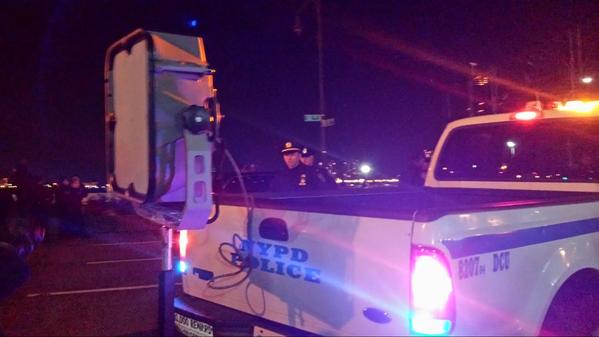
An LRAD being used by NYPD on Dec 3 (photo: @PeoplesHistory)
While the protests following the non-indictments in Ferguson and Staten Island have been disruptive, they have been mostly non-violent and clashes with police have been minimal, with the notable exception of the injury of two NYPD officers on the Brooklyn Bridge on the night of December 13.
However, on December 5 officers attempted to disperse a small march in Midtown using a new tool in crowd management, a long range acoustic device (LRAD).
LRADs have two primary functions: first as a long range communication device and second as a dispersal tool, emitting penetrating and piercing tones at high decibels.
LRADs were developed for the military following the terrorist attack on the USS Cole in October 2000 in Yemen. The purpose of the device was to ward off potential attackers before they could get close enough to an intended target to strike. The device has also been used at military checkpoints to communicate with and deter threatening vehicles.
The use of LRADs as a speaker may have some justification in crowd control. Best policing practices call for enhanced communication between demonstrators and the police. While this should be done face to face and on the ground as much as possible, there are situations where the police should notify crowds of their risk of arrest or of being subjected to use of force. Such crowds should be told where to disperse to and how. LRADs might be able to help with this since they can be heard over the shouts of crowds, unlike many conventional sound systems. However, we don't really know what if any harmful effects this function might produce, especially for people with existing hearing problems.
The dispersal function is similar to tear gas or water cannons. It is intended to be a less lethal use of force that can be used as an alternative to baton charges or other more extreme measures. Their use might be appropriate in dealing with a violent crowd attempting to storm the UN or other location where force might be necessary to prevent property destruction or injury. The effect, however, is usually rather crude. Like with tear gas, flash bang grenades, and riot control projectiles, the dispersal brought about by LRADs generally is disorderly and can lead to collateral property destruction and injury to onlookers and innocent by-standers. They should be used only as a last resort, in place of relying on higher levels of force.
The question of whether an LRAD is preferable to tear gas, projectiles, or flash bangs depends on balancing effectiveness in reducing violence and property destruction versus potential injury to protesters and onlookers. The problem is that we don't have very good evidence about the potential harmful effects of this relatively new and untested technology. There have been reports of related injuries leading to a legal settlement from LRAD use in Pittsburgh in 2009 and a ministerial report in Canada raised significant concerns about their health effects.
If we knew for sure that the dispersal function had no long term health consequences, then it might be preferable. If, however, there is a risk that those with existing hearing problems, and even others might experience medium to long term problems, or if psychological or cognitive functions are disrupted, then the costs may be too high. In the absence of clear evidence we should err on the side of caution.
One of my major concerns is that like with tasers and much military hardware, there is strong temptation for "mission creep." Often these devices are obtained under the pretext of very restricted uses in extreme and highly unlikely circumstances such as terrorist attacks or snipers. However, once departments have them, there is a tendency to use them in additional ways that make life easier for police but endanger the public.
Tasers can be life savers, but they can also be torture devices when used improperly. LRADs have this potential and we saw something like this when they were used during the Garner protests in New York. A few individuals in a larger group threw some things and the police used the dispersal function against the whole group on a Midtown street with no real plan for managing their dispersal. Other less dangerous methods could have been used and the effect on an already dispersed group was just to splinter them, making it harder for police to track them and leaving open the opportunity for random property destruction. Generally, this technology should not be used on a few troublemakers in an otherwise peaceful protest and it should not be used on more broadly violent crowds unless there are limited alternatives and a plan for managing an angry and disorganized splintering of the group.
Last week a group of lawyers sent a letter to the NYPD asking them to clarify their policies about the use of this technology. So far there has been no official response. There needs to be much greater transparency about the plans to use such intensive riot control tools. In fact, the NYPD also owns water cannons, and there has been no public discussion of their appropriate use either. It's time for the City Council to step in and hold hearings about the proper uses of riot control equipment in the New York.
***
Alex S. Vitale is associate professor of sociology at Brooklyn College and author of City of Disorder: How the Quality of Life Campaign Transformed New York Politics. He is senior policy adviser to hte Police Reform Organizing Project and serves on the New York State Advisory Committee to the US Civil Rights Commission. You can follow him on Twitter: @avitale
A Working Solution for Homelessness
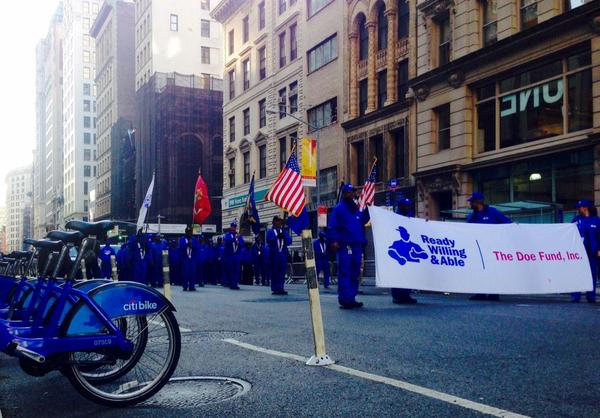
Members of the Doe Fund march in the Veterans Day Parade (photo: @TheDoeFund)
In a December 11 Gotham Gazette editorial advocating for more supportive housing, a program director from the Goddard Riverside Community Center made a bold statement: "The number one cause of homelessness[...]is a lack of affordable housing." That's a clean explanation for one of society's most vexing problems, but it's not true.
If housing was the answer to homelessness, we would have solved this crisis a generation ago. Homelessness isn't a state of being; and it's not a condition that people must live with and manage, like diabetes or cancer. It's an outcome. In a small fraction of the cases, it's the result of a serious disability that precludes a person's ability to work. But to say that all—or even most— homeless people require subsidized housing implies that they as a "group" are incapable of supporting themselves. And that line of reasoning is offensive to advocates like me, who know this population and have served them for decades.
Permanent supportive housing is our responsibility to provide for people who are profoundly disabled. But it also requires enormous and unending support from taxpayers. What happens when programs change, budgets get cut, and the money runs out? The homeless people warehoused in supportive housing are back on the streets, without any of the tools they need to live independently. To make supportive housing possible and sustainable for those who really do need it, we need a strong city with a strong workforce.
Any way you slice it, the answer to both our growing homelessness crisis and our need to build supportive housing is work.
The city, the state—the nation as a whole— has to recognize the dignity and potential in our homeless and long-term unemployed populations. We need programs that address not just a bad outcome, like homelessness, but the complex web of barriers, behaviors, and circumstances that have produced it: education, skills and experience gaps, vocational training and workforce development, substance abuse treatment, and reentry support for the formerly incarcerated.
When my husband and I started our work thirty years ago, people told us there was no way to put the homeless to work. They were lost causes; they would never be able to support themselves. They were simply "too lazy, or too crazy."
We can all agree that that's a disgusting statement. But is it really so far from dismissing all homeless people as permanently disabled? I can think of at least 21,000 individuals who would beg to differ; they're just some of the people we've served over the last three decades. They didn't come to our organization for a free house. They came to us for an opportunity: to work, to grow, and to support themselves and their families—for life.
Ms. McCullough of Goddard Riverside is right: the measure of a society is how it treats its most vulnerable members. Let's start by recognizing their dignity and abilities. Then, let's give them the hand up they deserve, one that frees them from homelessness forever; not a handout that keeps them trapped, right where they are.
***
Harriet McDonald is the Executive Vice President of The Doe Fund, a nonprofit organization that provides transitional housing, paid work, job training, and supportive services for the formerly homeless and incarcerated. Find The Doe Fund on Twitter: @TheDoeFund
****
Have an op-ed idea or submission for Gotham Gazette? E-mail editor Ben Max: This email address is being protected from spambots. You need JavaScript enabled to view it.
The 2014 Republican Victory for New York State Senate: Impressive...and Fragile
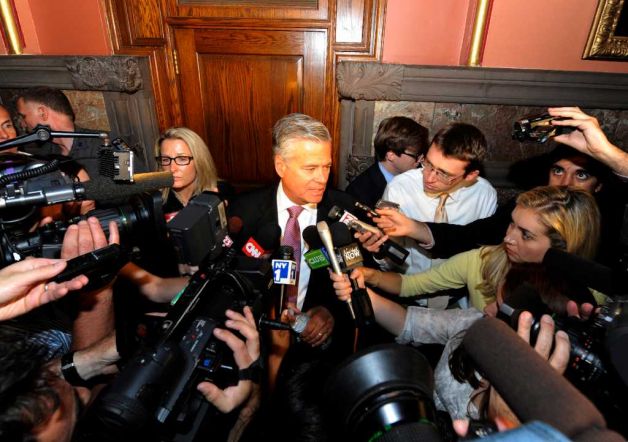
Republican Senate leader Dean Skelos (photo: Skip Dickstein/Times Union)
The decisive GOP return to control of the New York State Senate has been attributed to many causes: disproportionate resources, clever campaign tactics, individual candidate strengths and frailties, the coattails of a nationwide "Republican sweep." All are plausibly contributory to this impressive Republican win. Most important, however, are these four structural and tactical factors: gerrymandering, a strikingly smaller electorate, selective voter drop-off among those who turned out, and systematic statewide inter-party coalition building.
New York did its typical bi-partisan gerrymander in 2010. Republicans designed the Senate districts; Democrats did those for the Assembly. Nonetheless, in 2012 there were a number of unexpected GOP losses in areas of rapid demographic change, for example the Hudson Valley. After his vote for same sex marriage, long time Dutchess County GOP veteran Senator Steve Saland was knocked out in a three way race. In a neighboring district across the Hudson, Democrat Cecilia Tkaczyk used late big-money backing to win by a hair's breadth. Republican victories this year in both of these same GOP designed districts might be regarded as "a return to gerrymandered normal."
The electorate was unexpectedly small. A smaller electorate favors Republicans, who are disproportionately in demographic groups that are more likely to vote. The reasons:
First, the usual: It was not a presidential year: Turnout in New York is always lower in the even numbered years in which we elect a Governor than in those in which we elect a President.
This said, turnout was a million votes lower in 2014 than in 2010, the previous gubernatorial year. Why?
There was an incumbent governor running, with little perceived competition. The top of the ticket race thus did not bring voters to the polls. Andrew Cuomo also benefitted from the deterrent effect of a massive political bank roll and a record that appealed to right-center voters. Though he ran a lively campaign, Rob Astorino, the Republican candidate for governor, suffered from the self-fulfilling prophecy problem. He was written off early and relentlessly by analysts as an under-funded sure loser.
Many normally Democrat voters were mad at the governor: disaffected government reformers and social-activist liberal Democrats to his left, public employees in the center.
Additional evidence that Democrats disproportionately did not vote is that low turnout was not evenly distributed across the state. About half the proportion of eligible voters in overwhelmingly Democrat New York City (21.1%) cast ballots compared to voters outside the city (42.6%).
Politics generally is in disrepute. A November, 2014 Pew Research Center report documented that trust in government continued at "historic lows." Stay-at-homes may not participate because "voting 'just encourages them.'"
Add in another usual pattern, down-ticket voter drop-off. About 10% of the people who came out to vote cast no ballot in a Senate election. We can't tell what party each of these 381,000 voters might have favored, but we know that these down-ticket dropouts lived disproportionately in Long Island and upstate districts that elected Republican Senators.
All this resulted in a Republican total for Senate candidates (1,355,591) about 175,000 greater than Rob Astorino's for Governor, and just 26,385 fewer than cast for all Senate Democrat candidates in this dark blue state.
Then there's what New York pols call "the cross." Cross-endorsed candidates for office in New York may run on multiple party "lines." While much attention focused on whether the Republican/Independent Democrat (IDC) coalition would persist following the election, there was little given to the systematic pre-election coalition that the Republican Senate campaign effort cemented with the Conservative and Independence parties. The Republicans wrote off 15 Senate districts entirely (13 in NYC), and had mere token candidacies in at least another seven. This left 41; in 34 of these GOP candidates, whether challenged or not, had both the Conservative and Independence Party ballot lines. With few exceptions, Democrats with the Independence line were either unchallenged or IDC members.
The total Conservative vote in Senate races (251,103) exceeded that on this line for the race for Governor. The Independence total for Senate contests (185,427) was more than double that for Andrew Cuomo at the top of the ticket, even after removing Mark Grisanti's 21,826 votes in the unusual four-way contest in Erie County's Senate District 60. Almost all of these third party votes went to Republican Senate candidates.
Focus on these particulars brings into question any prediction of an incipient GOP resurgence in New York State politics. Many senior Republican Senators are aging; so are many of those who voted for them. Republican Senate candidates got clear majorities of those that turned out in fewer than half the districts they won (15 of 32) and in nine of these there was no Democrat on the ballot. If patterns hold, as they likely will, the 2016 New York electorate will be about two million or more voters bigger than that of 2014. And specific circumstances in the presidential race - e.g. a Hillary Clinton candidacy - may drive the New York participation up even further. Cross endorsement is volatile, and sometimes two edged. The base of GOP power in New York State government is still most fragile. If the GOP planning to protect its win did not begin on the morning of November 5, 2014 (the day after Election Day), it started too late.
***
Gerald Benjamin, Distinguished Professor of Political Science, is director of the Center for Research Regional Engagement and Outreach at SUNY New Paltz (CRREO).
Sadie Godlis, a major in Political Science, is a student researcher at CRREO.
***
Have an op-ed idea or submission for Gotham Gazette? E-mail editor Ben Max: This email address is being protected from spambots. You need JavaScript enabled to view it.

